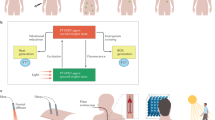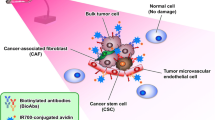Abstract
Purpose
The term “theranostics” represents a new paradigm in medicine especially for cancer treatment. This term was coined by Funkhouser in 2002 and defines a reagent that combines therapeutic and diagnostic properties. It is widely believed that theranostics agents will have considerable impact on healthcare before, during, and after disease by improving cancer prognosis and management simultaneously. Current theranostics approaches still rely on passive tumor targeting strategies, which have scattergun effects and tend to damage both neoplastic and non-neoplastic cells.
Methods
Here we describe a simple, controlled, and efficient method to generate homogeneous photoimmunotheranostics reagents. This method combines molecular optical imaging, photodynamic therapy, and immunotherapy using SNAP-tag technology. SNAP-tag is a derivative of the O(6)-alkylguanine-DNA alkyltransferase (AGT) which has the ability to efficiently conjugate to O(6)-benzylguanine (BG) molecules under physiological conditions depending on its folding pattern.
Results
The theranostics agent was able to specifically recognize various epidermal growth factor receptor (EGFR)-expressing skin cancer cell lines using flow cytometry analysis and confocal microscopy and eliminate them at EC50’s of 32–55 nM.
Conclusions
These experiments provide a framework for using SNAP-tag technology to generate homogeneous photoimmunotheranostics reagents with unified pharmacokinetic and therapeutic profiles. Furthermore, the reagent generated in this work could be used to simultaneously monitor and suppress the growth of skin squamous carcinoma and melanoma cells expressing EGFR.




Similar content being viewed by others
References
Agarwal P, Bertozzi CR (2015) Site-specific antibody-drug conjugates: the nexus of bioorthogonal chemistry, protein engineering, and drug development. Bioconjug Chem. doi:10.1021/bc5004982
Agbai ON, Buster K, Sanchez M, Hernandez C, Kundu RV, Chiu M, Roberts WE, Draelos ZD, Bhushan R, Taylor SC, Lim HW (2014) Skin cancer and photoprotection in people of color: a review and recommendations for physicians and the public. J Am Acad Dermatol. doi:10.1016/j.jaad.2013.11.038
Allison RR, Sibata CH (2010) Oncologic photodynamic therapy photosensitizers: a clinical review. Photodiagnosis Photodyn Ther. doi:10.1016/j.pdpdt.2010.02.001
Boni L, David G, Mangano A, Dionigi G, Rausei S, Spampatti S, Cassinotti E, Fingerhut A (2015) Clinical applications of indocyanine green (ICG) enhanced fluorescence in laparoscopic surgery. Surg Endosc. doi:10.1007/s00464-014-3895-x
Gautier A, Juillerat A, Heinis C, Correa IR Jr, Kindermann M, Beaufils F, Johnsson K (2008) An engineered protein tag for multiprotein labeling in living cells. Chem Biol. doi:10.1016/j.chembiol.2008.01.007
Gross A, Niemetz-Rahn A, Nonnenmacher A, Tucholski J, Keilholz U, Fusi A (2015) Expression and activity of EGFR in human cutaneous melanoma cell lines and influence of vemurafenib on the EGFR pathway. Target Oncol. doi:10.1007/s11523-014-0318-9
Hermanson GT (2013) Chapter 20: antibody modification and conjugation. In: Hermanson GT (ed) Bioconjugate techniques, 3rd edn. Academic Press, Boston, pp 867–920
Hobbs C, Nahar VK, Ford MA, Bass MA, Brodell RT (2014) Skin cancer knowledge, attitudes, and behaviors in collegiate athletes. J Skin Cancer. doi:10.1155/2014/248198
Hu LK, Hasan T, Gragoudas ES, Young LH (1995) Photoimmunotherapy of human uveal melanoma cells. Exp Eye Res 61:385–391
Huang Z (2005) A review of progress in clinical photodynamic therapy. Technol Cancer Res Treat 4:283–293
Huang YY, Vecchio D, Avci P, Yin R, Garcia-Diaz M, Hamblin MR (2013) Melanoma resistance to photodynamic therapy: new insights. Biol Chem. doi:10.1515/hsz-2012-0228
Hussain AF, Kampmeier F, von Felbert V, Merk HF, Tur MK, Barth S (2011) SNAP-tag technology mediates site specific conjugation of antibody fragments with a photosensitizer and improves target specific phototoxicity in tumor cells. Bioconjug Chem. doi:10.1021/bc200304k
Hussain AF, Kruger HR, Kampmeier F, Weissbach T, Licha K, Kratz F, Haag R, Calderon M, Barth S (2013) Targeted delivery of dendritic polyglycerol–doxorubicin conjugates by scFv-SNAP fusion protein suppresses EGFR+ cancer cell growth. Biomacromolecules. doi:10.1021/bm400410e
Kampmeier F, Ribbert M, Nachreiner T, Dembski S, Beaufils F, Brecht A, Barth S (2009) Site-specific, covalent labeling of recombinant antibody fragments via fusion to an engineered version of 6-O-alkylguanine DNA alkyltransferase. Bioconjug Chem. doi:10.1021/bc9000257
Kampmeier F, Niesen J, Koers A, Ribbert M, Brecht A, Fischer R, Kiessling F, Barth S, Thepen T (2010) Rapid optical imaging of EGF receptor expression with a single-chain antibody SNAP-tag fusion protein. Eur J Nucl Med Mol Imaging. doi:10.1007/s00259-010-1482-5
Kim SJ, Park Y, Hong HJ (2005) Antibody engineering for the development of therapeutic antibodies. Mol Cells 20:17–29
Majumdar P, Nomula R, Zhao J (2014) Activatable triplet photosensitizers: magic bullets for targeted photodynamic therapy. J Mater Chem C. doi:10.1039/C4TC00659C
Mitsuanga M, Nakajima T, Sano K, Choyke PL, Kobayashi H (2012) Near infrared theranostic photoimmunotherapy (PIT): repeated exposure of light enhances the effect of immunoconjugate. Bioconjug Chem. doi:10.1021/bc200648m
Mitsunaga M, Ogawa M, Kosaka N, Rosenblum LT, Choyke PL, Kobayashi H (2011) Cancer cell-selective in vivo near infrared photoimmunotherapy targeting specific membrane molecules. Nat Med. doi:10.1038/nm.2554
Mitsunaga M, Nakajima T, Sano K, Kramer-Marek G, Choyke PL, Kobayashi H (2012) Immediate in vivo target-specific cancer cell death after near infrared photoimmunotherapy. BMC Cancer. doi:10.1186/1471-2407-12-345
Nakajima T, Sano K, Mitsunaga M, Choyke PL, Kobayashi H (2012) Real-time monitoring of in vivo acute necrotic cancer cell death induced by near infrared photoimmunotherapy using fluorescence lifetime imaging. Cancer Res. doi:10.1158/0008-5472.can-12-1298
Palumbo A, Hauler F, Dziunycz P, Schwager K, Soltermann A, Pretto F, Alonso C, Hofbauer GF, Boyle RW, Neri D (2011) A chemically modified antibody mediates complete eradication of tumours by selective disruption of tumour blood vessels. Br J Cancer. doi:10.1038/bjc.2011.78
Peng X, Draney DR, Volcheck WM, Bashford GR, Lamb DT, Grone DL, Zhang Y, Johnson CM (2006) Phthalocyanine dye as an extremely photostable and highly fluorescent near-infrared labeling reagent. In: Proc. SPIE 6097, Optical molecular probes for biomedical applications, vol 6097. pp 60970E–60970E-12
Petershans A, Wedlich D, Fruk L (2011) Bioconjugation of CdSe/ZnS nanoparticles with SNAP tagged proteins. Chem Commun (Cambridge England). doi:10.1039/c1cc12874d
Piazena H, Kelleher DK (2010) Effects of infrared-A irradiation on skin: discrepancies in published data highlight the need for an exact consideration of physical and photobiological laws and appropriate experimental settings. Photochem Photobiol. doi:10.1111/j.1751-1097.2010.00729.x
Spallone G, Botti E, Costanzo A (2011) Targeted therapy in nonmelanoma skin cancers. Cancers. doi:10.3390/cancers3022255
Staneloudi C, Smith KA, Hudson R, Malatesti N, Savoie H, Boyle RW, Greenman J (2007) Development and characterization of novel photosensitizer: scFv conjugates for use in photodynamic therapy of cancer. Immunology. doi:10.1111/j.1365-2567.2006.02522.x
Verma S, Miles D, Gianni L, Krop IE, Welslau M, Baselga J, Pegram M, Oh DY, Dieras V, Guardino E, Fang L, Lu MW, Olsen S, Blackwell K (2012) Trastuzumab emtansine for HER2-positive advanced breast cancer. N Engl J Med. doi:10.1056/NEJMoa1209124
Yuan Y, Duff ML, Sammons DL, Wu S (2014) Retrospective chart review of skin cancer presence in the wide excisions. World J Clin Cases. doi:10.12998/wjcc.v2.i3.52
Acknowledgments
The authors thank Dr. Stefano DiFiore from Fraunhofer IME and Nina Berges from Institute of Applied Medical Engineering for their support in confocal microscopy.
Authors’ contributions
V. V. and D. B. performed the experiments. A. F. H. and S. B. were responsible for project planning and discussing the results. V. V. and D. B. drafted the manuscript. A. F. H. and S.B. revised the manuscript.
Author information
Authors and Affiliations
Corresponding author
Ethics declarations
Conflict of interest
All the Authors declare that they have no conflict of interest.
Ethical approval
This article does not contain any studies with human participants or animals performed by any of the authors.
Additional information
Verena von Felbert, Dirk Bauerschlag, Stefan Barth and Ahmad Fawzi Hussain have equally contributed to this work.
Rights and permissions
About this article
Cite this article
von Felbert, V., Bauerschlag, D., Maass, N. et al. A specific photoimmunotheranostics agent to detect and eliminate skin cancer cells expressing EGFR. J Cancer Res Clin Oncol 142, 1003–1011 (2016). https://doi.org/10.1007/s00432-016-2122-7
Received:
Accepted:
Published:
Issue Date:
DOI: https://doi.org/10.1007/s00432-016-2122-7




